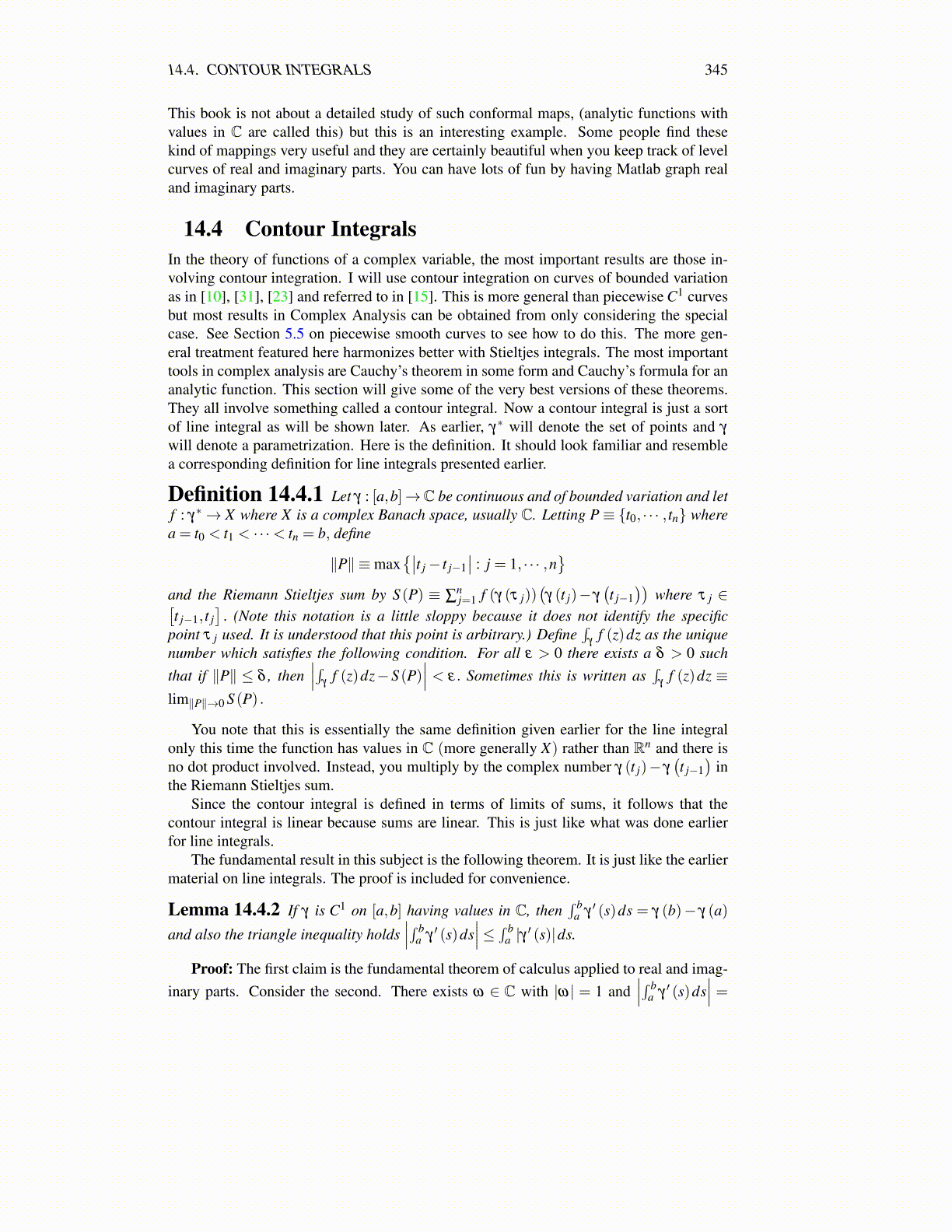
14.4. CONTOUR INTEGRALS 345
This book is not about a detailed study of such conformal maps, (analytic functions withvalues in C are called this) but this is an interesting example. Some people find thesekind of mappings very useful and they are certainly beautiful when you keep track of levelcurves of real and imaginary parts. You can have lots of fun by having Matlab graph realand imaginary parts.
14.4 Contour IntegralsIn the theory of functions of a complex variable, the most important results are those in-volving contour integration. I will use contour integration on curves of bounded variationas in [10], [31], [23] and referred to in [15]. This is more general than piecewise C1 curvesbut most results in Complex Analysis can be obtained from only considering the specialcase. See Section 5.5 on piecewise smooth curves to see how to do this. The more gen-eral treatment featured here harmonizes better with Stieltjes integrals. The most importanttools in complex analysis are Cauchy’s theorem in some form and Cauchy’s formula for ananalytic function. This section will give some of the very best versions of these theorems.They all involve something called a contour integral. Now a contour integral is just a sortof line integral as will be shown later. As earlier, γ∗ will denote the set of points and γ
will denote a parametrization. Here is the definition. It should look familiar and resemblea corresponding definition for line integrals presented earlier.
Definition 14.4.1 Let γ : [a,b]→C be continuous and of bounded variation and letf : γ∗→ X where X is a complex Banach space, usually C. Letting P≡ {t0, · · · , tn} wherea = t0 < t1 < · · ·< tn = b, define
∥P∥ ≡max{∣∣t j− t j−1
∣∣ : j = 1, · · · ,n}
and the Riemann Stieltjes sum by S (P) ≡ ∑nj=1 f (γ (τ j))
(γ (t j)− γ
(t j−1
))where τ j ∈[
t j−1, t j]. (Note this notation is a little sloppy because it does not identify the specific
point τ j used. It is understood that this point is arbitrary.) Define∫
γf (z)dz as the unique
number which satisfies the following condition. For all ε > 0 there exists a δ > 0 suchthat if ∥P∥ ≤ δ , then
∣∣∣∫γf (z)dz−S (P)
∣∣∣ < ε. Sometimes this is written as∫
γf (z)dz ≡
lim∥P∥→0 S (P) .
You note that this is essentially the same definition given earlier for the line integralonly this time the function has values in C (more generally X) rather than Rn and there isno dot product involved. Instead, you multiply by the complex number γ (t j)− γ
(t j−1
)in
the Riemann Stieltjes sum.Since the contour integral is defined in terms of limits of sums, it follows that the
contour integral is linear because sums are linear. This is just like what was done earlierfor line integrals.
The fundamental result in this subject is the following theorem. It is just like the earliermaterial on line integrals. The proof is included for convenience.
Lemma 14.4.2 If γ is C1 on [a,b] having values in C, then∫ b
a γ ′ (s)ds = γ (b)− γ (a)
and also the triangle inequality holds∣∣∣∫ b
a γ ′ (s)ds∣∣∣≤ ∫ b
a |γ ′ (s)|ds.
Proof: The first claim is the fundamental theorem of calculus applied to real and imag-inary parts. Consider the second. There exists ω ∈ C with |ω| = 1 and
∣∣∣∫ ba γ ′ (s)ds
∣∣∣ =